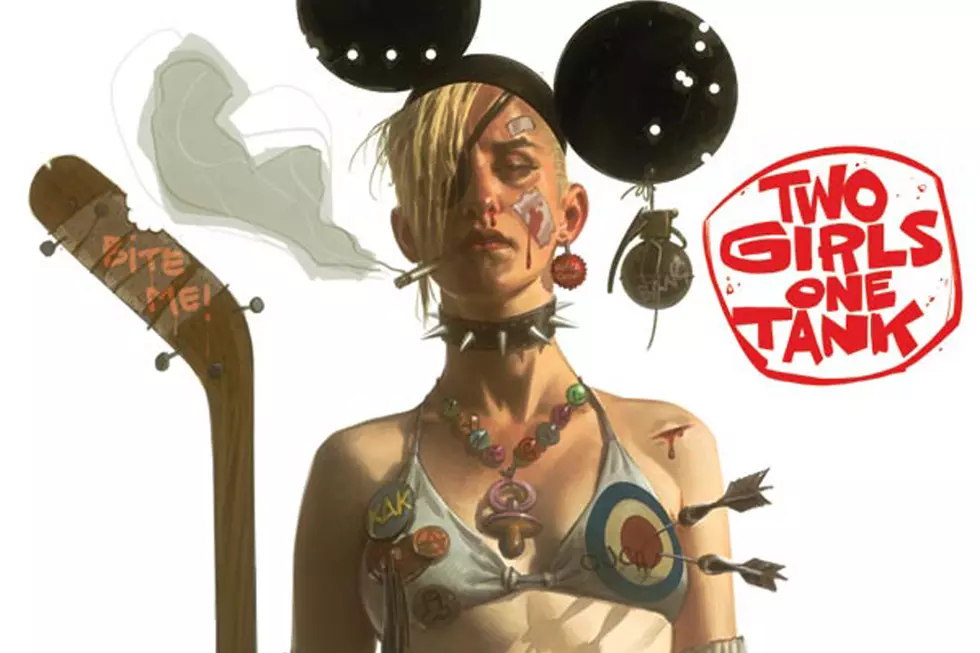
Future-Punk Wastelands and Virtual Bands: Celebrating the Cartoon Creativity of Jamie Hewlett!
A teenage girl who sleeps with a mutant kangaroo and has a fetish for military hardware. A virtual cartoon band that have sold millions of (actual) records. An era-defining hit single about class warfare. These are but three of the concepts that Jamie Hewlett has visually constructed, over the course of a career that has spanned comics, music, fashion, and numerous other facets of popular culture.
The 1980s was an era of widespread revolution in the UK comics scene, with creators like Alan Moore, Grant Morrison, Neil Gaiman, Brian Bolland, Peter Milligan, Brendan McCarthy, Jamie Delano, Dave Gibbons, Dave McKean, and Steve Dillon making huge waves, armed with an arsenal of insane ideas and a disregard for established structures. Dystopian totalitarianism, hyper-fueled psychedelia, deconstructive superheroics, psycho-analytical dreamscapes, anarchic post-apocalyptic science-fiction, and other brain-twisting compound genres were the order of the day, as a generation weaned on cheaply-printed fantasies made the medium over in their own image and unleashed their imaginations in the pages of publications like Doctor Who Magazine, Captain Britain, 2000 AD, and Warrior. By the end of the decade, British writers and artists had effectively pulled off a friendly coup of the industry and were producing work for DC and other USA-based comic publishers, reinventing the American form and selling it back to its homeland in much the manner that The Beatles and their contemporaries had with rock and roll two decades earlier.
And in October 1988, the first issue of a new publication appeared on the shelves of British newsagents. Founded by Dillon and fellow 2000 AD alumnus Brett Ewins, Deadline defied easy categorization – a sort of crazed indie-punk hybrid of music magazine and cartoon anthology, one that featured text interviews alongside boundary-shattering comics by a number of up-and-coming talents. In fact, the cover of issue #1 showcased a feature that would prove to be Deadline's calling card: a strip called Tank Girl that mixed Mad Max post-apocalyptic adventure with a distinctly of-the-moment attitude of sexual and political liberation.
While co-creator Alan Martin's avant-bizarro stories and concepts provided the framework for the comic's immediate impact, it was artist Jamie Hewlett's illustrative ethic that drove the message home with the cover image – a clean-lined, cartoony depiction of a knowing troublemaker, arresting but in no way sexualized, full of conviction and personality and clearly in control of her own destiny. She's holding a shattered mirror, shaving her head, staring straight toward the reader, paying no attention to her own reflection or appearance. It's immediately iconic, it defines the character in one moment – no tank, no guns, no kangaroo, nothing but attitude and expression, no shirt, and no seductive intent or effect. It's totally provocative, totally in-your-face, and tells you nothing while establishing everything you need to know.
And if that one thing, if that initial Tank Girl work was all that Mr. Hewlett had done, we'd still be talking about him today. He could've faded into obscurity, and still been immortal, but instead, he continued to push forward. He drew covers for Peter Milligan's Shade, The Changing Man series for DC. He illustrated a Milligan-written Tank Girl mini-series for Vertigo. He created a comic strip called Get The Freebies for fashion/culture magazine The Face. He adapted the lyrics of Pulp's "Common People" (a #2 UK hit, and probably the single enduring and important single of the Britpop era) into comic form for a special promotional booklet. He collaborated with a number of musical acts, and contributed artwork and design to the not-entirely-successful (but admirably bizarre) Tank Girl movie. And as the new millennium dawned, he teamed with his friend, Blur frontman Damon Albarn, on a project that blurred the lines between the worlds of pop music and cartoons even further.
Gorillaz was envisioned as a "virtual band" in the mode of The Archies, an animated quartet of characters that occupied a surreal, ever-changing world. 2001's self-titled debut album welded Albarn's patented yearning melodic songwriting to worldbeat, dub, and Hip-Hop textures, and incorporated contributions from a number of guest artists – while Hewlett expanded on his signature visual style to define the looks and personalities of the four fictional band members through album art and promotional materials, and in a series of widely acclaimed animated videos. This canvas allowed Hewlett to let his imagination wander unchecked, following the cartoon quartet through a world of supernatural rappers, missile-equipped dune buggies, martial arts moves, futuristic cityscapes, and Zombie apes doing the "Thriller" dance.
The wide success of Gorillaz has allowed Hewlett room to keep experimenting and creating, cooking up visuals for the band's concert performances, (utilizing live musicians, projection screens, and 3D animations), masterminding three follow-up albums (and their accompanying videos), producing a coffee-table art book, and even designing a line of band-branded Converse sneakers. He's also continued to create in other capacities, providing some images for 2014's 21st Century Tank Girl series, branching out into the fine art world with series of paintings, collages, and drawings, and collaborating with Albarn on the non-Gorillaz (but similarly genre-bending) Monkey: Journey To The West theatrical production and an animated sequence for the Beijing 2008 Olympics. He's constantly on the move, trying new things, and avoiding any attempt at easy categorization.
So on the occasion of his birthday on April 3rd, we at ComicsAlliance are happy to celebrate the never-resting creative muse of Jamie Hewlett – from indie comics to chart-topping records to groundbreaking animation, his artistry never fails to entertain, amuse, and inspire.
More From ComicsAlliance

![12 Facts You May Not Have Known About Gorillaz [Music Week]](http://townsquare.media/site/622/files/2017/01/gorillaz.jpg?w=980&q=75)
![Join Tank Girl Down The Furry Road In ‘Tank Girl: Gold’ From Martin And Parson [Exclusive Preview]](http://townsquare.media/site/622/files/2016/09/Tank-Girl-Featured.jpg?w=980&q=75)

![Alan Martin and Brett Parson Revive Tank Girl in ‘Two Girls One Tank’ #1 [Preview]](http://townsquare.media/site/622/files/2016/03/tankgirl_featured.png?w=980&q=75)

![Gorillaz Artist Jamie Hewlett Returns to Tank Girl in ’21st Century Tank Girl’ [Preview]](http://townsquare.media/site/622/files/2015/04/21st_century_tank_girl_feat.jpg?w=980&q=75)
![Exclusive: Titan Comics Unveils ‘Best of British’ Month in May [Video]](http://townsquare.media/site/622/files/2015/02/bestofbritish.jpg?w=980&q=75)

